Nobody should be surprised to learn that the HPI was down again in May. Here’s a view from the peak:
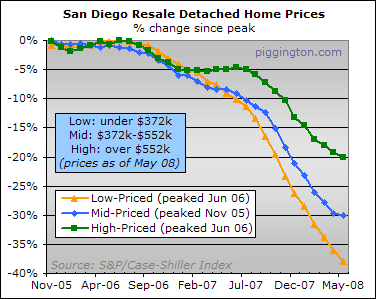
For the month, the low tier was down 2.9%, the middle tier .6%, and the upper tier 1.1%. What’s this? The upper tier fell more than the middle tier. This is the first month that’s happened, to my knowledge.
The aggregate index was down 1.4% for the month and is down 28.9% since the November 2005 peak.
The HPI proxy based on size-adjusted median predicted a decline of .9% vs. the actual 1.4%, so it was a bit optimistic for May.
The following list shows the last time prices were this low for each tier:
- Low tier: April 2003
- Middle tier: September 2003
- High tier: March 2004
- Aggregate: October 2003
More charts below over different time periods:
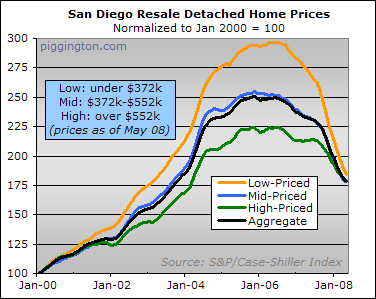
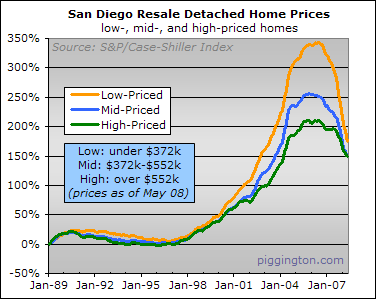
And the same thing adjusted for CPI inflation:
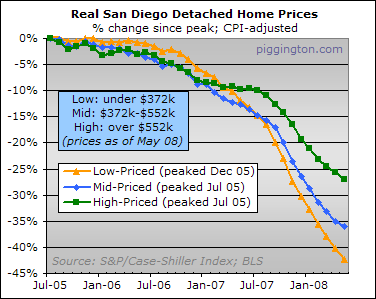
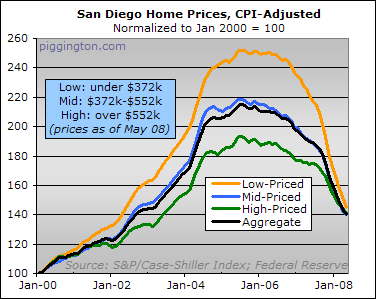
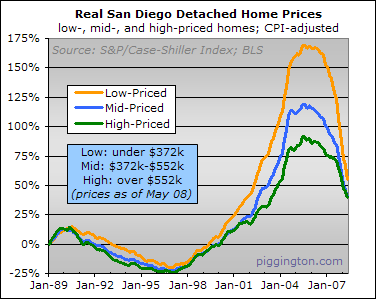

Interesting stuff Rich. The
Interesting stuff Rich. The worst of excess appreciation occurred post September 2003. We seem to be at/below those levels already in the low to mid tiers. I’ve always believed that the froth (appreciation between late 2003 and mid 2005) would come off much easier than the rest (appreciation between 2001 and late 2003).
I’ll be watching with a special interest as we go forth. We have a bit more easy work left for the next 4 to 6 months and my belief is a slower more painful decline thereafter.
I guess we gotta just wait and see.
sdrealtor wrote:Interesting
[quote=sdrealtor]Interesting stuff Rich. The worst of excess appreciation occurred post September 2003. We seem to be at/below those levels already in the low to mid tiers. I’ve always believed that the froth (appreciation between late 2003 and mid 2005) would come off much easier than the rest (appreciation between 2001 and late 2003).[/quote]
Most housing bulls seem to expect the bottom to come shortly after a return to this pre-froth era, then hit the ground running. The problem is that correction came when all economic fundamentals were still good: unemployment was low, stocks were still rising, inflation was “contained”, dollar was stronger, and so on.
Now, however that’s all changed. Everything in our economy that thrived off that “frothy”, speculative period is now suffering. There’s a good write up on the paper-money about the timing.
“The problem is that
“The problem is that correction came when all economic fundamentals were still good: unemployment was low, stocks were still rising, inflation was “contained”, dollar was stronger, and so on.”
I agree with that view. We have to keep in mind that home prices benefited from both the dot com bubble and then of course a much more pronounced housing/credit bubble. The wild card moving forward is what will be the underlying economy as the correction unfolds? I like paying attention to Calculated Risk’s take on Roubini’s view on the economy. CR doesn’t anticipate a severe recession, Roubini does. Here is CR’s last post taking on Roubini.
http://calculatedrisk.blogspot.com/2008/07/roubini-global-recession-watch.html
It looks like CR is leaving a door open for a more pronounced recession.
Interesting that this year’s
Interesting that this year’s seasonal strength was much weaker than 2006 or 2007. The downturn in prices appears to continue accelerating on a seasonally adjusted basis.
Tentative observations based
Tentative observations based on this data.
It does not mean that we are at the bottom, but I believe it worth noting that the mid and upper tiers are now at the rough level of the 96/7 bottom when adjusted at a 5% pa rate to account for growth in buying power: approx the growth in nominal national income. This indicates an approach down to at least fair value for these sectors of the market but does not of course stop overshoot. . If the rental is now covering borrowing costs for the typical rental units in these areas, , the two ways of looking at valuation would then start to indicate that a long term buyer is not irrational in buying in those areas now: especially given that the CS index is quite a few months behind events.
All bets still off though for the lower tier which needs to run off the excessive relative appreciation of this sector in the market and for the many reason advanced by Piggies.
It does not mean that we are
It does not mean that we are at the bottom, but I believe it worth noting that the mid and upper tiers are now at the rough level of the 96/7 bottom when adjusted at a 5% pa rate to account for growth in buying power
So you’re saying that wage inflation outpaced CPI by 5% every year since 96/97? However, since 2001 all but the rich just barely kept pace with CPI. I’m not sure our buying power is really that much higher than 96/97.
What happens to prices when
What happens to prices when the historical ratio of home price to income returns?
San Diego prices got way out of whack with income to home price ratios. In 1999 most areas of San Diego, the ratio of home price to income was about 4 times income levels. (4 to 1) which is at the high end on a national level, but people have always been willing to pay a premium for living here.
The rational of this ratio is that in normal times, sensible lenders will only loan 28% of a borrowers income to be allow for mortgage payments. When you do the math, this works out to a maximum amount of 4 times income for a loan.( 80% of all homes are purchased with a mortgage, so cost and ability to get a loan is a major factor) During the boom, 2003-06, home prices to income ratios got up to 11 to 1 in some areas of San Diego. A borrower with $1800 to spend on a mortgage with a 3% interest only loan suddenly could service a $720,000 mortgage, even though this house price was 9 times his/her income.
Now in 208 it’s back to reality and borrowers have essentially the same income levels. But now it’s a 6.5% fully amortized loan with tighter standards. That $1800 payment will only service a $284,000 mortgage. This is a home price 4 times income or where it should be. The difference between $720,000 and $284,000 is your bubble. There is a great tool found at http://www.UsHousingMeltdown.org where you can type in a zip-code and see what happens to home values when the income to home price ratio returns to the historical norm for the area.
Ryan
That is an interesting
Ryan
That is an interesting tool. The question I have is they seem to be comparing the median detached home price with the median income. Shouldnt they be using the overall median for all housing types?
BTW, according to the calculator for the lowest my home could go according to the fundamentals, I got about 15% depreciation left from current levels. The figure also happens to coincide with the value I hypothesized my home would bottom at back in 2006 when I started analyzing the bubble in earnest 2.5 years ago.
sdr
Rich,
How does the C-S index
Rich,
How does the C-S index account for falling prices and tier? Specifically, when a property falls from the high range to the middle range or from the middle to the lower range, in which category is the property considered to belong?
The reason I ask is that if a given property changes categories as the market falls, then the index will make the upper tier appear better than it really is.
I understand that this effect was seen during the depression with bonds. The reason the best bonds did “well” is that as a bond was downgraded, it was dropped from the AAA rating where it originated to a lower tier. Those bonds that maintained their ratings of course outperformed those that didn’t.
Watch the High-tier.
I’m
Watch the High-tier.
I’m betting that we see some serious accelerated declines in those areas in the next 6-12 months with the Prime, Alt-A and Pay-option ARM loans hitting the wall… unless Aguirre flys in with his cape and saves everyone… hahahahaha
Hey, CR has got the same
Hey, CR has got the same idea…
http://calculatedrisk.blogspot.com/2008/08/lenders-fear-second-wave-of-defaults.html